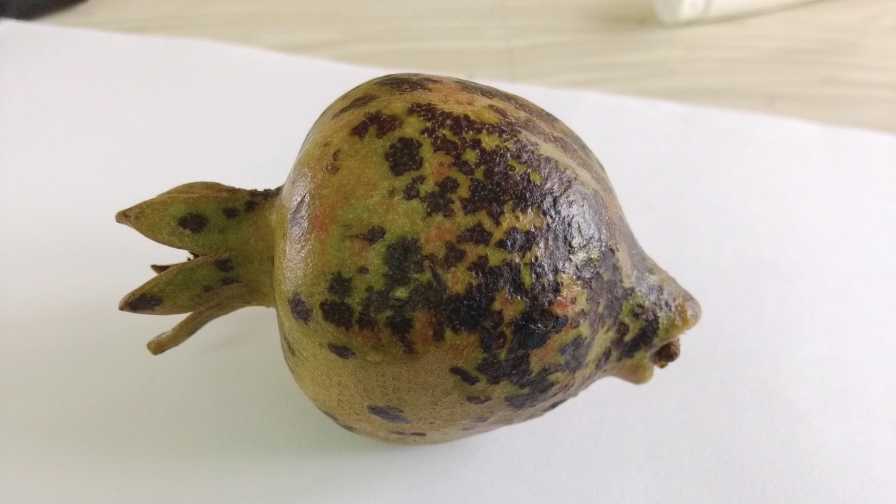Ways to Price out Pomegranate Production in Florida

Cercospora is one of several diseases that can impact pomegranates grown in Florida.
Photo by Rupert Anand Yumlembam
While the pomegranate industry is in its fledgling stages in Florida, researchers and growers are focusing on finding the right varieties and production practices to create a viable alternative crop in. According to the Florida Pomegranate Association, there was about 150 acres of the crop planted as of 2017.
Due to the interest among growers, researchers at the UF/IFAS Gulf Coast Research and Education Center published a paper on pomegranate establishment and production practices costs. The study looked at establishment, irrigation, pruning, fertilization, and pest management. It did not investigate harvest and postharvest expenses.
The cost data were collected through personal interviews with six pomegranate growers in fall 2014. The interviewed growers plant pomegranate for commercial opportunities. Because Florida pomegranate production is still in its infancy and production practices vary significantly across growers, the costs described in this study are incomplete and provide only a reference for cost items discussed. The total establishment cost of a pomegranate orchard is approximately $4,000 per acre. The total cultural cost (includes fertilization, weed management, and pruning) of a pomegranate orchard is roughly $1,030 per acre.
Establishment
Growers planted the container-grown transplants on a 12-feet by 18-feet spacing, with 202 trees per acre. A wider spacing of 18-feet by 18-feet is used in Georgia and California. Single-trunk trees require less space than bushes, which have broader canopies. Pomegranate cuttings are generally propagated in 1-gallon or 3-gallon pots in nurseries. 1-gallon potted plants are less than one year old and cost $8 to $12 in 2014, while 3-gallon potted plants are taller and older and cost $20 to $25, depending on the varieties. The planting labor cost is estimated at $2 per tree. After the plants are set in the field, pine bark mulch is applied to aid in plant establishment.
Mulch moderates soil temperature, aids in weed control, and adds organic matter to the soil. A pine bark strip about 4 feet wide extending down the row provides a good substrate for surface feeder roots. The mulch cost is estimated at $2 per tree.
Finding varieties that grow, flower, and yield is still a challenge. UF/IFAS is collaborating with local pomegranate growers in experimental trials to identify optimal cultivars suited for Florida. The preliminary results show there are some yield merits in the ‘Girkanets,’ ‘Kazake,’ ‘Wonderful,’ ‘Al-sirin-nar,’ and ‘Medovyi Vahsha’ varieties.
Irrigation
Irrigation is installed before planting. Growers most commonly use drip emitters or microjet sprinklers. Drip emitters are low-volume and provide good root coverage for young trees. However, when trees mature, more coverage will be required. This can be achieved with adding more emitters or microjets.
Microjets are higher volume and could provide cold protection. The establishment cost of an irrigation system includes the materials cost ($800 per acre) for microsprinklers and installation labor cost ($400 per acre).
During the dry season, for trees planted in central ridge sandy soil, growers irrigate only once per week for 15 to 20 minutes for trees less than one year old, and twice per week for about 60 minutes each time for trees more than two years old. In areas with clay soil, growers often do not need to irrigate their trees. Over-irrigation can cause fruit split. The optimal irrigation practices for pomegranate trees require further research.
Pruning
Pomegranate trees do not require extensive pruning in the early years. In the first year, growers remove suckers originating from below the ground. After the first year, single-trunk trees need more pruning than bushes. The growers interviewed suggest removing small tree branches if they are dead, damaged, or criss-crossed.
Mature trees and bushes are pruned on a regular basis, with heavier pruning in spring and winter than in summer. It is estimated that it takes 11 hours to prune one acre of trees/bushes in summer, compared to 32 hours in spring and 48 hours in winter.
Fertilization
Young trees are fertilized every one to two months, and the amount of fertilizer applied increases each year. Trees more than three years old receive three to four nutritional sprays during the year. One practice adopted by a grower is to apply 82 pounds per acre nitrogen fertilizer, 224 pounds per acre 10-10-10 (nitrogen-phosphorous-potassium) fertilizer, and 300 pounds per acre 8-6-8 fertilizer. Besides fertilizers, foliar micronutrients are also applied as a supplement.
Weeds, Bugs, and Diseases
Pomegranate growers use a system of weed-free strips under the trees. Generally, a strip of 4 to 5 feet wide is maintained weed free. The weed-free zone is sprayed 2 to 3 times each year, which could occur in March, June, and October.
Aphids have been identified as one of the primary pests in pomegranate trees/bushes. Pesticide application frequency depends on current and expected pest pressure and the life cycle of pests. Disease control is important in Florida due to its subtropical climate. Growers have to apply fungicides routinely, in contrast to the occasional application of insecticides. Some diseases found include but are not limited to Cercospora, Botryosphaeria, Anthracnose, and Alternaria leaf blight. Fungicide-resistant diseases are a growing concern for growers.
Read the full report in detail at http://edis.ifas.ufl.edu/fe1024.









